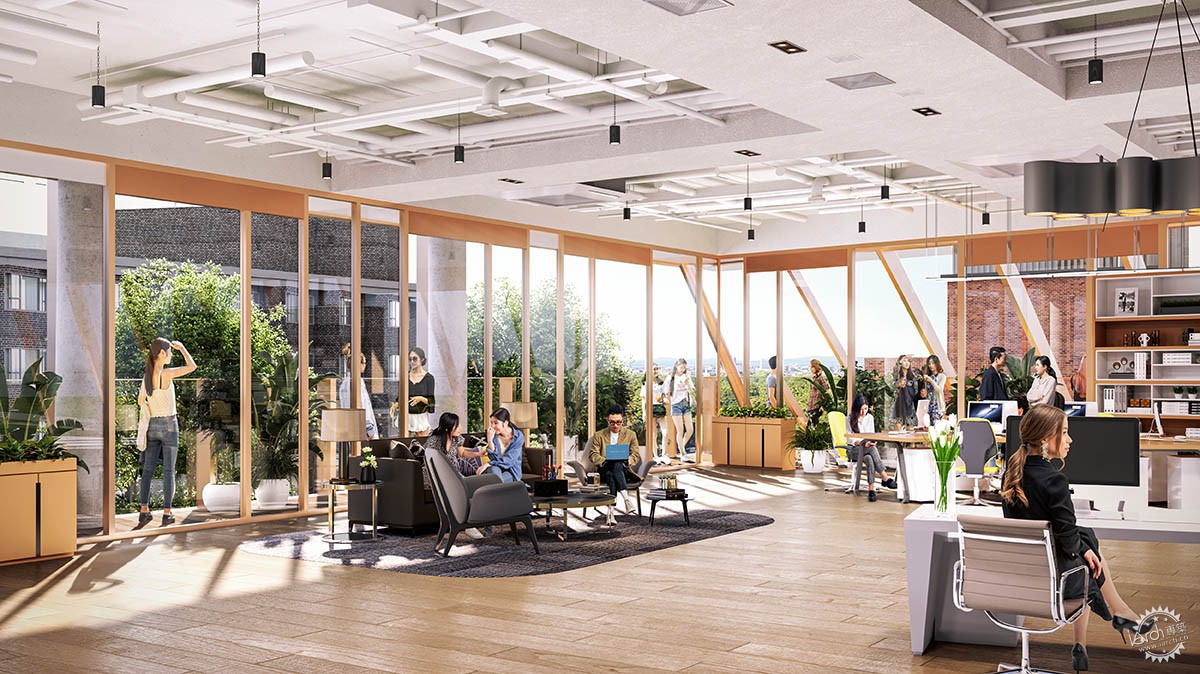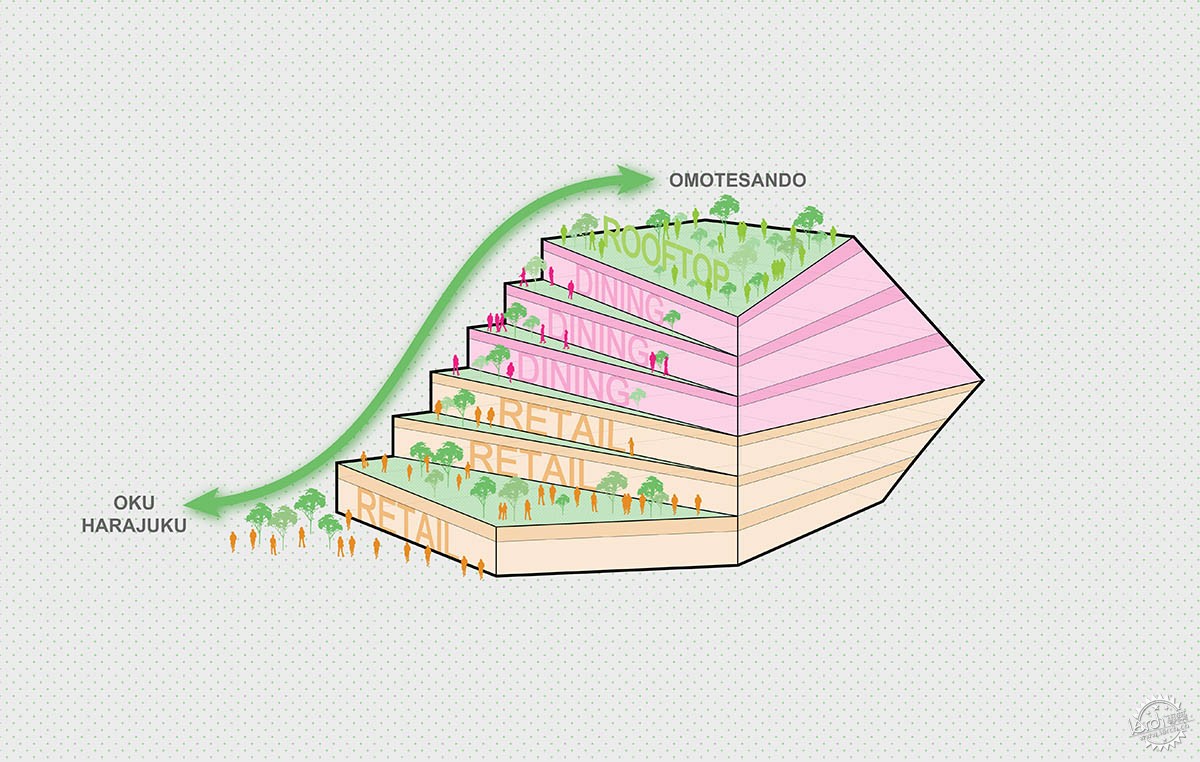
OMA展示了其在东京原宿(Harajuku)设计的以扭曲和雕塑感为特色的商业文化中心方案
OMA Reveals Harajuku Quest Mixed-Use Scheme Featuring Twisted And Sculptural Expression In Tokyo
由专筑网江鹏,小R编译
OMA建筑事务所公布了其在日本东京原宿(Harajuku)设计的多功能建筑的方案,该方案以扭曲和雕塑感的形体表达为特色。
这座名为Harajuku Quest的建筑占地84000平方英尺(8082平方米),根据“受压和受拉”的形体逻辑进行设计,以打造出雕塑般的建筑形体。
该建筑由Shigematsu Shohei Shigematsu和OMA New York联合体为NTT Urban Development公司设计,建筑的前三层为零售空间,餐饮空间位于上面三层。屋顶是一个露台,由中心的绿植表皮包裹。
OMA已于10月开始施工,该公司计划在2025年2月完成项目。
OMA has revealed design for its new mixed-use scheme that features a twisted and sculptural expression in Tokyo, Japan.
Called Harajuku Quest, the 84,000-square-feet (8,082-square-metre) complex is being designed according to the contextual parameters driven by "pinching and pulling" approach to create a sculptural expression.
Designed by Shohei Shigematsu and OMA New York for NTT Urban Development, the building consists of retails spaces on the first three floors, while dining spaces are placed on the upper three floors. The rooftop is dedicated to a terrace wrapped by a large green wall at the center.
OMA has begun construction in October and the firm plans to complete the project in February 2025.

作为表参道(Omotesando)和原宿(Oku-Harajuku)两个区域的结合点,项目场地距离代代木公园、明治神宫和原宿车站等主要公共空间很近,Harajuku Quest是NTT努力将原宿改造为充满活力的城市生活新阶段。
一旦完成,Harajuku Quest将是该公司在表参道开发的第一个地上多功能建筑综合体。
Acting as a binder of the two areas of the site: Omotesando and Oku-Harajuku–a short distance away from major public destinations including Yoyogi Park, Meiji Jingu, and Harajuku Station–Harajuku Quest is a new phase of NTT’s effort to transform an area of Harajuku with energetic, urban life.
Once complete, Harajuku Quest will be the firm’s first ground-up mixed-use building in Omotesando.

OMA在其项目描述中说:“该项目建立在NTT对原宿城市发展规划基础上,该项目于2020年开放,是一个大型城市发展规划项目,该项目将促进新的流线与城市中的小巷、广场和商业区进行非正式接触和交流。”
新的设计方案旨在邀请人们参加表参道和原宿的公共活动,同时在地理位置上也首次连接两个区域。
"The project builds upon NTT’s “With Harajuku”, opened in 2020, and a larger urban development to facilitate a new flow of people through a series of alleys, squares, and commercial zones for informal encounters and exchange," said OMA in its project description.
The new scheme is aimed to invite people and to be opened to activities from both Omotesando and Oku-Harajuku, while connecting the two areas of the site for the first time.

OMA合伙人Shigematsu Shohei Shigematsu说:“表参道和原宿的区域结合体现了城市文脉以及东京时尚和零售文化的二元性。”
“新建筑必须连接两个区域,讲述两个区域特色。”
“就像一枚硬币的两面,即使是单一的建筑也传递着不同的个性特征,并通过新的公共走廊连接起来。”
Shigematsu补充说:“Harajuku Quest是表参道和原宿的地理位置和规划层面的交汇点,在这里游客可以同时体验全球时尚和当地文化的活动和氛围。”
"The conjunction of Omotesando and Oku-Harajuku embodies a duality of urban context as well as Tokyo’s fashion and retail culture," said Shohei Shigematsu, OMA Partner.
"It was essential for the new building to bridge the two areas and express two stories."
"Like two sides of the same coin, a single building conveys alternate personalities, connected by a new public corridor."
"Harajuku Quest acts as both a visual and programmatic convergence point of Omotesando and Oku-Harajuku—a gathering place where visitors can experience the activities and aura of global fashion and local cultural scene simultaneously," Shigematsu added.

该公司补充说:“表参道主要由一个轴向大道和蜿蜒、非线性的街道构成,通过榉树、宽阔的人行道和一系列全球知名品牌的旗舰店定义出明显的城市文化特征。”
“随着时间的推移,零售商业建筑对表现力品牌的需求日益增长,促进了街道上建筑规模的增长,商店也变得只在主轴方向强调自身的独特。”
“就在表参道主轴线的北面,原宿提供了一种更亲密的体验,紧凑、有机的街道空间和容纳有独立商店的人性化建筑构成的城镇中的‘乡村’景观。”
该公司继续说:“自20世纪70年代以来,该社区培养了独特的青年文化和创意运动,街头时尚得到全球认可和影响。”
"Omotesando presents a rare axial thoroughfare in an area predominantly defined by winding, non-linear streets, with a strong urban identity defined by zelkova trees, wide sidewalks, and string of flagships of well-recognized global brands," the firm added as related to the context.
"The growing need for expressive branding in retail architecture has contributed to the growth of building scales on the street over time, with stores emphasizing distinct identities only toward the main axis."
"Just north beyond Omotesando’s mainstream corridor, Oku-Harajuku offers a more intimate experience—a “village” townscape of tight, organic streets and human-scale buildings housing independent shops."
"Since the 1970’s, the neighborhood has cultivated a distinct youth culture and creative movement with a global recognition and influence on streetstyle fashion," the firm continued.

考虑到两个区域环境的两种不同特征,工作室采用了两个分区范围内不同设计手法的单一表达。
“受压和受拉”是关键的设计理念,决定了建筑朝向表参道的雕塑感形体表达,而朝向原宿的宜居性立面特征表达。
Considering the two different characters of contexts, the studio created a single expression that is shaped by two different manipulations within the site’s zoning envelope.
"Pinching and pulling" are the key design components that define the sculptural expression of the building toward Omotesando and stepping and fanning for an inhabitable façade toward Oku-Harajuku.

建筑的每一面都提供了不同的视角,而朝向表参道的是一个整体的,透明的立面。建筑在顶部有一个退台的处理,可以引入光线,在地面上的后退形成一个漏斗状的行人通道,通往原宿区。
该方案秉持了“广阔的垂直性”这一理念,还创建了一系列的宜人尺度的露台,并将各种各样的开放空间置入其中,并向原宿延伸。
The building offers different perspectives from each side, while "a monolithic, transparent" façade rises towards Omotesando. It has a setback at the top to bring light in and set back at the ground to make a funneling pedestrian passage to Oku-Harajuku.
The scheme, defending "an expansive verticality", also creates a series of human-scale terraces rising in steps and incorporates variegated, open spaces for programs to spill out toward Harajuku.

在第二层的露台上,有一个公共空间放大点,它被设计成一个大型的文化项目和集会广场,将社区生活延伸到场地内,并超越传统的零售体验。
该项目由纽约OMA建筑事务所设计,由合伙人Shohei Shigematsu和合伙人Takeshi Mitsuda主持设计。
On the second level terrace there is a public datum that is expanded to form a large plaza for cultural programs and gatherings, extending neighborhood life into the site and the building activity beyond the traditional retail experience.
The project is designed by OMA New York, led by Partner Shohei Shigematsu and Associate Takeshi Mitsuda.











项目信息
项目名称:Harajuku Quest
建筑师:OMA
地点:日本东京
负责合伙人:Shohei Shigematsu
合伙人:Takeshi Mitsuda
团队:Timothy Tse、Yuzaburo Tanaka、Kohei Sugishita、Chiao Yang、Fernan Bilik、Tetsuo Kobayashi
执行建筑师:NTT Facilities
结构:NTT Facilities
MEP:NTT Facilities
景观设计师:Landscape Plus
照明:Lighting Planners Associates
图形、标识、Wayfinding:Daikoku Design Institute, Bikohsha
总承包商:Kumagai Gumi
客户:NTT UD
所有图片均由OMA和Inplace提供。
所有图纸©OMA。
Project facts
Project name: Harajuku Quest
Architects: OMA
Location: Tokyo, Japan
Partner-in-Charge: Shohei Shigematsu
Associate: Takeshi Mitsuda
Team: Timothy Tse, Yuzaburo Tanaka, Kohei Sugishita, Chiao Yang, Fernan Bilik, Tetsuo Kobayashi
Executive Architect: NTT Facilities
Structure: NTT Facilities
MEP: NTT Facilities
Landscape Architect: Landscape Plus
Lighting: Lighting Planners Associates
Graphics, Signage, Wayfinding: Daikoku Design Institute, Bikohsha
General Contractor: Kumagai Gumi
Client: NTT UD
All images courtesy of OMA and Inplace.
All drawings © OMA.
|
|
